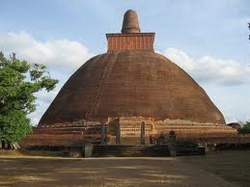Difference between revisions of "Abhayavāpi"
Jump to navigation
Jump to search
| (2 intermediate revisions by one other user not shown) | |||
| Line 1: | Line 1: | ||
[[File:Index142.jpg|thumb|250px|]] | [[File:Index142.jpg|thumb|250px|]] | ||
| − | |||
| − | |||
| − | The hall which Dutthagāmani built round the | + | |
| − | In the reign of Bhātikābhaya water was taken from the tank, by means of machines, up to the top of the [[Mahā Thūpa]], for the sprinkling of the [[Flowers]] offered there (Mhv.xxxiv.45). | + | |
| − | The tank is generally identified with the modern Basavakkulam (Geiger, Mhv. trans. 74, n.3). | + | |
| + | |||
| + | |||
| + | |||
| + | '''[[Abhayavāpi]]''': A tank in [[Anurādhapura]] built by [[King]] [[Pandukābhaya]] (Mhv.x.88). At its lower end was the settlement of the [[yakkha]] [[Cittarāja]] (Mhv.x.84). | ||
| + | |||
| + | In the [[hot]] weather it ran dry, and on one occasion [[Devānampiyatissa]] used its mud for building a temporary {{Wiki|structure}} in which to deposit the [[relics]] brought from [[Jambudīpa]] (Mhv.xvii.35). | ||
| + | |||
| + | The hall which [[Dutthagāmani]] built round the [[Maricavatti Vihāra]] extended into a part of the [[Abhaya]] tank (Mhv.xxvi.20). | ||
| + | |||
| + | In the reign of [[Bhātikābhaya]] [[water]] was taken from the tank, by means of machines, up to the top of the [[Mahā Thūpa]], for the sprinkling of the [[Flowers]] [[offered]] there (Mhv.xxxiv.45). | ||
| + | |||
| + | The tank is generally identified with the {{Wiki|modern}} Basavakkulam (Geiger, Mhv. trans. 74, n.3). | ||
| + | |||
| + | |||
{{R}} | {{R}} | ||
[http://www.palikanon.com/english/pali_names/am/abhayavaapi.htm www.palikanon.com] | [http://www.palikanon.com/english/pali_names/am/abhayavaapi.htm www.palikanon.com] | ||
[[Category:Buddhist Terms]] | [[Category:Buddhist Terms]] | ||
| − | + | {{PaliTerminology}} | |
Latest revision as of 16:31, 24 January 2024
Abhayavāpi: A tank in Anurādhapura built by King Pandukābhaya (Mhv.x.88). At its lower end was the settlement of the yakkha Cittarāja (Mhv.x.84).
In the hot weather it ran dry, and on one occasion Devānampiyatissa used its mud for building a temporary structure in which to deposit the relics brought from Jambudīpa (Mhv.xvii.35).
The hall which Dutthagāmani built round the Maricavatti Vihāra extended into a part of the Abhaya tank (Mhv.xxvi.20).
In the reign of Bhātikābhaya water was taken from the tank, by means of machines, up to the top of the Mahā Thūpa, for the sprinkling of the Flowers offered there (Mhv.xxxiv.45).
The tank is generally identified with the modern Basavakkulam (Geiger, Mhv. trans. 74, n.3).
